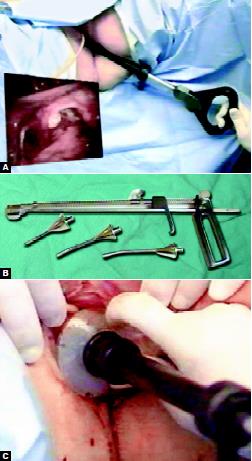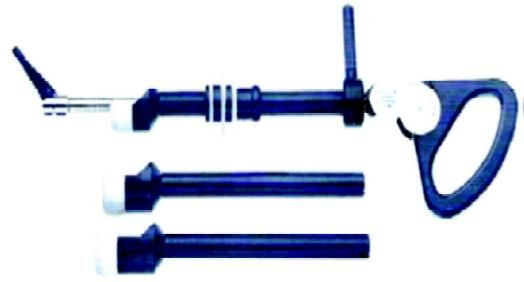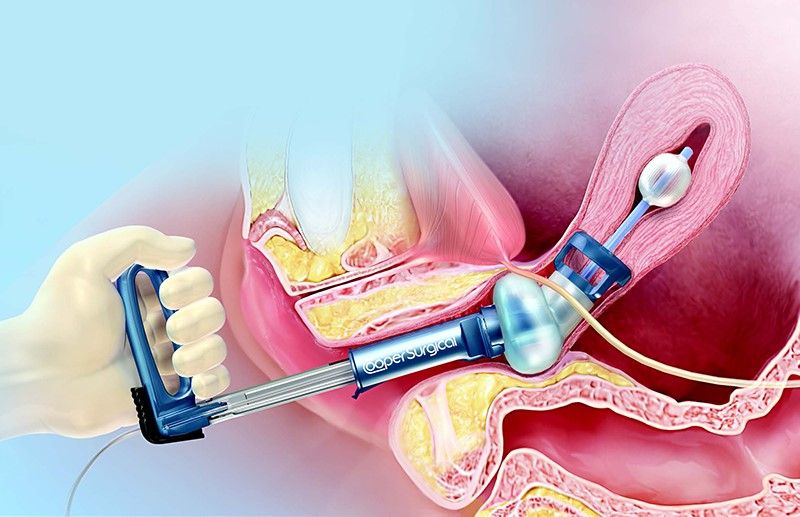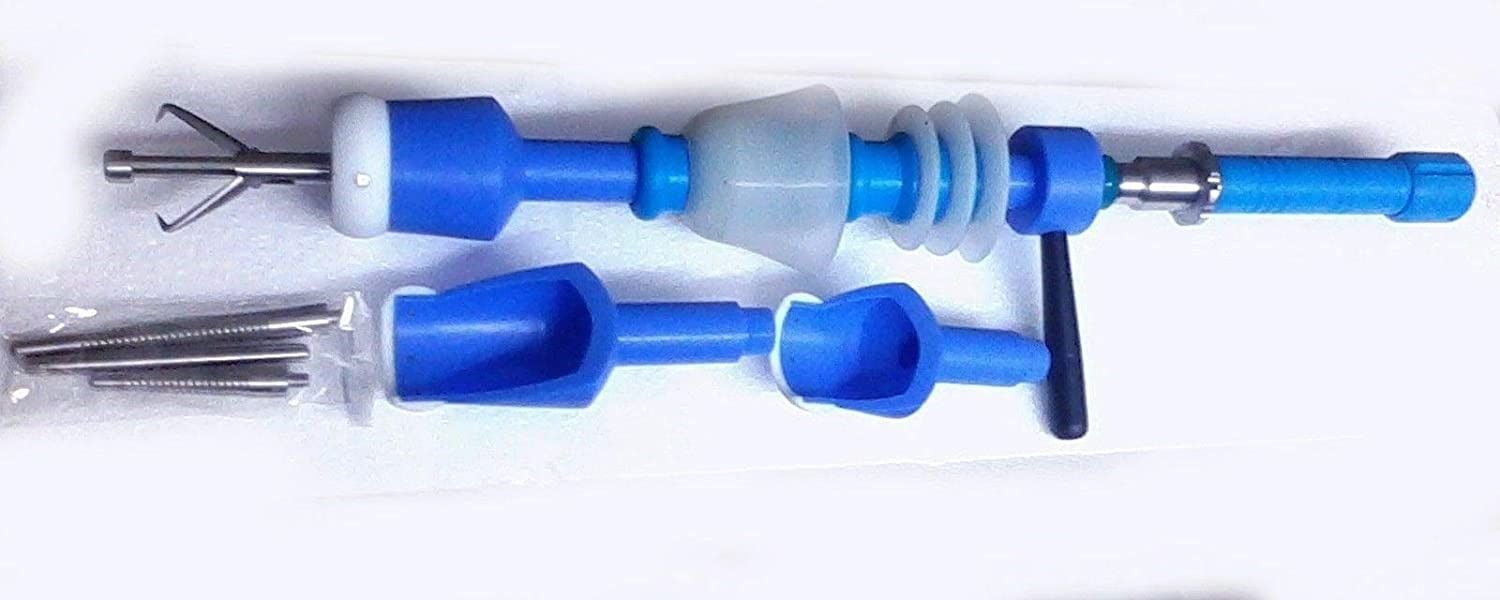Laparoscopic Uterine Manipulator
The uterine manipulator is one of the very essential instruments for mobilization of the uterus, identification of the vaginal fornices, and sealing of the vagina during a hysterectomy. There are different types of uterine manipulators. Their most obvious function is to suitably mobilize the uterus. By anteverting or retroverting the uterus, gynecologist gets a good exposure of both the anterior wall and vesicouterine fold, the posterior wall, and uterosacral ligaments. Lateral movements allow the exposure of the infundibulopelvic ligaments, utero-ovarian ligaments, and the anterior and posterior leaves of the broad ligament. These movements are important in cases of a large uterus. The elevation movement is important in cases of recto-vaginal endometriosis in which the uterus needs to be moved upward into the abdomen, providing the best exposure of the utero-sacral ligaments and the cul-de-sac. The ideal uterine manipulator should be inexpensive, convenient and quick to use, safe especially by avoiding the need for dilatation and a tenaculum, and have the ability to inject solutions into the uterine cavity and most importantly offer the optimal range of motion of the uterus while avoiding the need for an assistant.

(A) Lateral traction over uterus by uterine manipulator; (B) Different attachments of uterine manipulator; (C) Sealing of vagina with a cuff of the uterine manipulator for TLH
The uterine manipulator is used in most of the advanced gynecological procedures. Most uterine manipulators are essentially rigid instruments that are attached or fixed to the uterus, protrude from the vagina, and require the use of a tenaculum to grasp the cervix, which occasionally may bleed.
The Clermont-Ferrand uterine manipulator
The Clermont-Ferrand uterine manipulator provides a good 140° movement of the uterus in the anterior and posterior directions. In addition, it has the ability to flex the uterus on itself. Its graduated snap-in mechanism, which has five different positions, gives stability to the uterus at various angles, and the snap-in release button allows unrestricted movement. The manipulator rod, when pushed forward, helps to delineate the vaginal fornices with the help of an anatomical blade attached anteriorly. It has a series of silicon seals to maintain the pneumoperitoneum after the colpotomy incision. It is a reusable instrument. Though versatile, this instrument has its drawbacks; it requires cervical dilatation up to Hegar number 9 before its insertion in the cervix, so it may not be useful in cases of cervical stenosis. It is pretty complex to assemble and requires a fair amount of training to use this device properly. Clermont-Ferrand uterine manipulator seems to be a good choice for operative laparoscopies involving hysterectomy, endometriosis in the posterior cul-de-sac, and sling surgeries.

Clermont-Ferrand uterine manipulator
The RUMI manipulator
The RUMI manipulator with the KOH colpotomizer from Cooper Surgical is a versatile uterine manipulator. Not only does it have extremely good uterine manipulation in the anterior, posterior, and the lateral planes, it also helps with the very easy delineation of the vaginal fornices. The KOH-cup distances the ureter form the uterine vessels and facilitates its easy coagulation. This device helps to complete laparoscopic dissection of the cervix and vagina much more easily, resulting in greater efficacy and less blood loss while eliminating the difficulties pertaining to vaginal access. This enhanced uterine mobility also speeds Utero-vesical peritoneal dissection and inferior displacement of the bladder. Furthermore, the RUMI manipulator allows for significant lateral uterine displacement, improving visualization and ease of dissection of the uterine vasculature and broad ligament. The only drawback of this uterine manipulator is that it is partially disposable.

RUMI uterine manipulator
The Mangeshkar uterine manipulator
The Mangeshkar uterine manipulator is a reusable, completely detachable, low-cost uterine manipulator. Though specifically designed for total laparoscopic hysterectomy, it can be used in almost all gynecological laparoscopic surgeries. By appropriately mobilizing the handle, the uterus along with the adnexa can be manipulated from side to side and can be rotated along its long axis, thus enabling anteversion and retroversion as well as dextro and laevo rotation. Sliding in the Vaginal Delineator helps identify the vaginal fornices and choosing the right sized delineator drum helps maintain the pneumoperitoneum.
Thus, the Mangeshkar uterine manipulator offers advantages in its ability to perform a completely laparoscopic hysterectomy and other gynecological surgery by maintaining the loss of pneumoperitoneum. The significant uterine mobility that this system provides facilitates dissection of the ascending uterine arteries in a manner that reduces the risks of ureteric injury. Mangeshkar uterine manipulator is a fully autoclavable and reusable system.

Mangeshkar uterine manipulator
The uterine manipulator is one of the very essential instruments for mobilization of the uterus, identification of the vaginal fornices, and sealing of the vagina during a hysterectomy. There are different types of uterine manipulators. Their most obvious function is to suitably mobilize the uterus. By anteverting or retroverting the uterus, gynecologist gets a good exposure of both the anterior wall and vesicouterine fold, the posterior wall, and uterosacral ligaments. Lateral movements allow the exposure of the infundibulopelvic ligaments, utero-ovarian ligaments, and the anterior and posterior leaves of the broad ligament. These movements are important in cases of a large uterus. The elevation movement is important in cases of recto-vaginal endometriosis in which the uterus needs to be moved upward into the abdomen, providing the best exposure of the utero-sacral ligaments and the cul-de-sac. The ideal uterine manipulator should be inexpensive, convenient and quick to use, safe especially by avoiding the need for dilatation and a tenaculum, and have the ability to inject solutions into the uterine cavity and most importantly offer the optimal range of motion of the uterus while avoiding the need for an assistant.

(A) Lateral traction over uterus by uterine manipulator; (B) Different attachments of uterine manipulator; (C) Sealing of vagina with a cuff of the uterine manipulator for TLH
The uterine manipulator is used in most of the advanced gynecological procedures. Most uterine manipulators are essentially rigid instruments that are attached or fixed to the uterus, protrude from the vagina, and require the use of a tenaculum to grasp the cervix, which occasionally may bleed.
The Clermont-Ferrand uterine manipulator
The Clermont-Ferrand uterine manipulator provides a good 140° movement of the uterus in the anterior and posterior directions. In addition, it has the ability to flex the uterus on itself. Its graduated snap-in mechanism, which has five different positions, gives stability to the uterus at various angles, and the snap-in release button allows unrestricted movement. The manipulator rod, when pushed forward, helps to delineate the vaginal fornices with the help of an anatomical blade attached anteriorly. It has a series of silicon seals to maintain the pneumoperitoneum after the colpotomy incision. It is a reusable instrument. Though versatile, this instrument has its drawbacks; it requires cervical dilatation up to Hegar number 9 before its insertion in the cervix, so it may not be useful in cases of cervical stenosis. It is pretty complex to assemble and requires a fair amount of training to use this device properly. Clermont-Ferrand uterine manipulator seems to be a good choice for operative laparoscopies involving hysterectomy, endometriosis in the posterior cul-de-sac, and sling surgeries.

Clermont-Ferrand uterine manipulator
The RUMI manipulator
The RUMI manipulator with the KOH colpotomizer from Cooper Surgical is a versatile uterine manipulator. Not only does it have extremely good uterine manipulation in the anterior, posterior, and the lateral planes, it also helps with the very easy delineation of the vaginal fornices. The KOH-cup distances the ureter form the uterine vessels and facilitates its easy coagulation. This device helps to complete laparoscopic dissection of the cervix and vagina much more easily, resulting in greater efficacy and less blood loss while eliminating the difficulties pertaining to vaginal access. This enhanced uterine mobility also speeds Utero-vesical peritoneal dissection and inferior displacement of the bladder. Furthermore, the RUMI manipulator allows for significant lateral uterine displacement, improving visualization and ease of dissection of the uterine vasculature and broad ligament. The only drawback of this uterine manipulator is that it is partially disposable.

RUMI uterine manipulator
The Mangeshkar uterine manipulator
The Mangeshkar uterine manipulator is a reusable, completely detachable, low-cost uterine manipulator. Though specifically designed for total laparoscopic hysterectomy, it can be used in almost all gynecological laparoscopic surgeries. By appropriately mobilizing the handle, the uterus along with the adnexa can be manipulated from side to side and can be rotated along its long axis, thus enabling anteversion and retroversion as well as dextro and laevo rotation. Sliding in the Vaginal Delineator helps identify the vaginal fornices and choosing the right sized delineator drum helps maintain the pneumoperitoneum.
Thus, the Mangeshkar uterine manipulator offers advantages in its ability to perform a completely laparoscopic hysterectomy and other gynecological surgery by maintaining the loss of pneumoperitoneum. The significant uterine mobility that this system provides facilitates dissection of the ascending uterine arteries in a manner that reduces the risks of ureteric injury. Mangeshkar uterine manipulator is a fully autoclavable and reusable system.

Mangeshkar uterine manipulator





